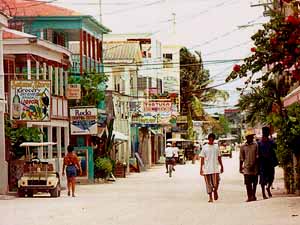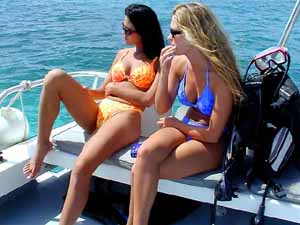All Over Belize in Boats, Planes, and Golf Cartsby: Keith M Swartz
In all the time we were here, most of which was spent on the island of Ambergris Caye, we set foot in a car twice: from the airport to our hotel, and from our hotel to the airport. Everything else was more...novel. The town of San Pedro on Ambergris Caye has about 15 automobiles. Three of them are bottle trucks that haul goods back and forth to the bottling factory, and the other 12 are minivans that double as the town's taxi service. As far as I could tell, no residents own a car, and you couldn't rent one even if you tried. Once we heard a car alarm, but that was just a passenger ferry telling those who got off to buy lunch or use the bathroom because the boat was getting ready to leave. So how do the locals get around? What else on a town whose roads are all no more than flattened sand: golf carts. Every day, walking along the streets, dozens of these silent, electric demons would pass us _ sometimes somebody hauling groceries, sometimes a small family on their way back from school, sometimes tourists going from resort to restaurant. Our hotel had planned to pick. us up in one (but we didn't have time to call to say we were coming). Our dive instructors took us to their place and to their diving boat in theirs. Yet as funny as it may seem, these things are totally electric, so they're quiet, and don't pollute. I think these islanders deserve a point for that.
With a bicycle or ATV, you can get to the far northern reaches of the town, on the other side of the "north river cut", which is what we did one day. This twenty-foot wide swath of water was created by Hurricane Janet in the early 60s, and to this day, prevents golf carts or other large modes of transport from getting across. But in the center, it's about four feet deep, so walking or biking across is unlikely to be productive. The Belizeans's answer to this is the hand-drawn ferry. For two Belizean dollars, which you only pay one way, two dark-skinned natives, who were most likely drinking too much the night before, will guide you onto a raft that looks about as sturdy as something built by Tom Sawyer, then grab a rope tethered to a tree on each end of the stream, and pull you across. The entire trip takes only a few minutes, but it's highly effective, unless you're the guy pulling the rope. For longer water crossings, the principal mode of transport is the water taxi. This is usually a 40+-foot motorboat with four times the horsepower of Erin's car. In about an hour, it speeds across the waters among two or three cayes and the "mainland", Belize City. The men that operate these boats seem to be completely impervious to waves, even if the passengers aren't, so it's imperative to remember that parkas are not included. At about one-quarter the cost of a plane ticket, it's a bargain; sure, it takes four times as long, but when you're talking about a difference of 45 minutes, it's a good deal.
Mexican border, to the island of Ambergris Caye. Total capacity of the plane: eight people, including the pilot. It was the first plane I'd ever been in where you could open the window to get some air. And if that wasn't enough of a thrill, our plane from Belize City to Flores, Guatemala was a Cessna 172. We failed to consider how small this flight was when the woman at the ticket counter said, "The flight is scheduled to depart at 3:30, but we'll probably just leave around 3." However, we did start to get suspicious when the ticket agent at the gate met us and said, "So you must be the passengers." When we walked onto the runway, we passed by small jets, smaller jets, and finally made it to our plane, which I only saw after I tripped over it. The Cessna is a four-seater: there's the pilot, copilot, and a bucket seat for two passengers. Since there was no copilot, Erin was promoted to the post from passenger, and thus got to ride in the "front". I tried to assume the duties of flight attendant, but there wasn't even an aisle down which to push the beverage cart...not that a cart would have fit in there, either. Erin spent the next 75 minutes looking out the front window of a plane, and checking out all the action on the dials and controls of this twenty-year old puddle-jumper. (I learned the age after reading the "in-flight magazine" found in the seat pocket in front of me: the Cessna 172 Operators Manual.) She proudly kept a straight face, even when the weather turned bad, with clouds thickening up and rain coming down in sheets pretty much right over where we needed to land. The captain shouted (only way to be heard over the engines) that we may have to turn back, but her persistence in finding an approach further to the north paid off, and we saved ourselves the indignity of having to turn around or run out of fuel, which is good, because as small a plane as it is, it's still no fun to have to push. Although I make the country seem like it's completely devoid of modern transportation, in fairness, things are little more different on the mainland. For instance, there are many more taxis and cars in Belize City. But to get outside of town, there are no trains or motor coaches; at this point, you invariably get to ride on everyone's favorite third-world nightmare-come-true, the chicken bus. These are almost always converted school buses, complete with yellow paint, rickety green seats, signs with instructions not to curse or bother the bus driver (or else serve detention), and, of course, no seatbelts. The "chicken" epithet may be unfair, since we never did see any caged animals on them, but they did get packed shoulder-to-shoulder with people from towns where I suspect they don't sell soap.
So, in the ten days we spent in Belize, we succeeded in shedding our all-American dependency on the automobile by relying on just about every other kind of transportation imaginable, except maybe for hot-air balloons and skateboards. We walked, swam, hitchhiked, and bounced along land, sea, and air in more ways than most people do in a lifetime. For a country where the only Mercedes emblems you'll see are on delivery trucks bound for Mexico, you have to hand it to them: at least they've got variety. It's just too bad they don't have seatbelts.
Click here to return to the main articles page.
|
 As Americans, we are all about cars. Everyone has one, sometimes
two or three, and we use them to go anywhere, even it's just around
the corner to get a cup of coffee, or, like Steve Martin in L.A.
Story, to visit the next-door neighbor. And while most of the world
relies on automobiles to a lesser extent, the same cannot be said
for the country of Belize.
As Americans, we are all about cars. Everyone has one, sometimes
two or three, and we use them to go anywhere, even it's just around
the corner to get a cup of coffee, or, like Steve Martin in L.A.
Story, to visit the next-door neighbor. And while most of the world
relies on automobiles to a lesser extent, the same cannot be said
for the country of Belize.  However, this is an island frequently ravaged by hurricanes, and so
golf carts can't take you everywhere. For those times, you need a
bicycle. Bikes are quite common, and inexpensive to rent, albeit you
only get a primitive zero-speed without seat padding, and working
brakes cost extra. There's also the occasional all-terrain vehicle
or motor scooter, but I only mention these for completeness; we were
never on one. Besides, an ATV doesn't sound like a logical mode of
transport on a flat island consisting solely of sand, but after a
few days of rain, it starts to make sense, when the roads get so
gutted that a short ride to the grocery store can amass hundreds of
dollars in chiropractor visits.
However, this is an island frequently ravaged by hurricanes, and so
golf carts can't take you everywhere. For those times, you need a
bicycle. Bikes are quite common, and inexpensive to rent, albeit you
only get a primitive zero-speed without seat padding, and working
brakes cost extra. There's also the occasional all-terrain vehicle
or motor scooter, but I only mention these for completeness; we were
never on one. Besides, an ATV doesn't sound like a logical mode of
transport on a flat island consisting solely of sand, but after a
few days of rain, it starts to make sense, when the roads get so
gutted that a short ride to the grocery store can amass hundreds of
dollars in chiropractor visits.
 Still, airplanes are more common than one might think. There are
more than two dozen flights coming into San Pedro every day,
although all the passengers put together wouldn't fill even half the
seats in a typical commercial shuttle flight. Our first plane flight
was from Corozal, just over the
Still, airplanes are more common than one might think. There are
more than two dozen flights coming into San Pedro every day,
although all the passengers put together wouldn't fill even half the
seats in a typical commercial shuttle flight. Our first plane flight
was from Corozal, just over the
 And for more remote areas, where the buses don't frequent, you can always
hitchhike, and hope to be picked up in the back of a pick-up truck, as we
did on our journey to Crooked Tree. Granted, this technically doesn't
count as a different form of transportation from a car, but I think riding
in the flatbed does merit mentioning as "something different".
And for more remote areas, where the buses don't frequent, you can always
hitchhike, and hope to be picked up in the back of a pick-up truck, as we
did on our journey to Crooked Tree. Granted, this technically doesn't
count as a different form of transportation from a car, but I think riding
in the flatbed does merit mentioning as "something different". 